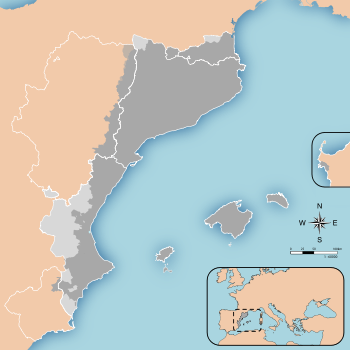DSSAT
DSSAT농업기술 이전 의사결정 지원시스템(DSSAT)은 농업용 작물 성장을 시뮬레이션하기 위한 컴퓨터 프로그램이다.[1]그것은 농학자들이 농법을 평가하는 데 100개 이상의 국가에서 사용되어 왔다.[2][3]한 응용 프로그램은 기후 변화의 농업에 미칠 수 있는 영향을 평가하고 적응 방법을 시험하는 것이었다.[4]null
DSSAT는 모듈식 접근방식으로 구축되며, 증발 및 토양 유기물 축적과 같은 공정을 나타낼 수 있는 여러 가지 옵션을 가지고 있어 농작물 성장에 중요한 공정을 서로 다르게 나타내는 시험을 용이하게 한다.[5][6][7]DSSAT의 기능성은 GIS와 같은 다른 소프트웨어와의 인터페이스를 통해 확장되었다.[2][8] DSSAT는 일반적으로 토양 상태, 날씨, 비료 사용 및 관개 같은 관리 관행, 재배되는 작물 품종과 관련된 입력 매개변수를 요구한다.[9]많은 일반 작물들은 DSSAT 모듈로서 이미 구현된 특성을 가지고 있다.[1]null
DSSAT는 1980년대에 IBSNAT(International Benchmark Sites Network for Agrotechnological Transfer)에서 성장했으며, 1989년에 첫 공식 출시되었다.[1]2003년에 출시된 버전 4는 농업 경제 분석과 위험 평가를 위한 더 많은 모듈형 구조와 추가 도구를 도입했다.[1]ICASA(International Consortium for the International Consortium for Emergative System Applications, ICASA)와의 제휴에서도 발전이 지속되고 있다.[10]null
메모들
- ^ a b c d Jones, J. W.; Hoogenboom, G.; Porter, C. H.; Boote, K. J.; Batchelor, W. D.; Hunt, L. A.; Wilkens, P. W.; Singh, U.; Gijsman, A. J.; Ritchie, J. T. (2003). "The DSSAT cropping system model". European Journal of Agronomy. 18 (3–4): 235. doi:10.1016/S1161-0301(02)00107-7.
- ^ a b Thorp, Kelly R.; Dejonge, Kendall C.; Kaleita, Amy L.; Batchelor, William D.; Paz, Joel O. (2008). "Methodology for the use of DSSAT models for precision agriculture decision support". Computers and Electronics in Agriculture. 64 (2): 276. doi:10.1016/j.compag.2008.05.022.
- ^ Baselala, Elenoa (July 5, 2012). "Agro tech". Fiji Times. Archived from the original on February 1, 2014. Retrieved January 23, 2014.
- ^ "Decision Support System for Agrotechnology Transfer (DSSAT) developed under the International Consortium for Agricultural Systems Applications (ICASA)". Compendium on methods and tools to evaluate impacts of, and vulnerability and adaptation to, climate change. UNFCCC Nairobi Work Programme on impacts, vulnerability and adaptation to climate change. Retrieved January 23, 2014.
- ^ Gijsman, A.J; Jagtap, S.S; Jones, J.W (2002). "Wading through a swamp of complete confusion: How to choose a method for estimating soil water retention parameters for crop models". European Journal of Agronomy. 18 (1–2): 77–106. doi:10.1016/S1161-0301(02)00098-9.
- ^ Meng, Lei; Quiring, Steven M. (2008). "A Comparison of Soil Moisture Models Using Soil Climate Analysis Network Observations". Journal of Hydrometeorology. 9 (4): 641. doi:10.1175/2008JHM916.1.
- ^ Porter, Cheryl H.; Jones, J. W.; Adiku, S.; Gijsman, A. J.; Gargiulo, O.; Naab, J. B. (2009). "Modeling organic carbon and carbon-mediated soil processes in DSSAT v4.5". Operational Research. 10 (3): 247. doi:10.1007/s12351-009-0059-1.
- ^ Thorp, K.R.; Bronson, K.F. (2013). "A model-independent open-source geospatial tool for managing point-based environmental model simulations at multiple spatial locations". Environmental Modelling & Software. 50: 25–36. doi:10.1016/j.envsoft.2013.09.002.
- ^ Wu, Chunlei; Anlauf, Ruediger; Ma, Youhua (2013). "Application of the DSSAT Model to Simulate Wheat Growth in Eastern China". Journal of Agricultural Science. 5 (5). doi:10.5539/jas.v5n5p198.
- ^ White, J. W.; Hunt, L. A.; Boote, K. J.; Jones, J. W.; Koo, J.; Kim, S.; Porter, C. H.; Wilkens, P. W.; Hoogenboom, G. (2013). "Integrated description of agricultural field experiments and production: The ICASA Version 2.0 data standards". Computers and Electronics in Agriculture. 96: 1–12. doi:10.1016/j.compag.2013.04.003.


